Schneider Electric Bundle
How did a French iron foundry become a global leader in energy management?
Journey through the remarkable Schneider Electric SWOT Analysis to uncover the fascinating Schneider history! From its humble beginnings in 1836 as an iron and steel manufacturer, Schneider Electric has continuously evolved. Discover how this French multinational strategically navigated the industrial revolution and beyond.
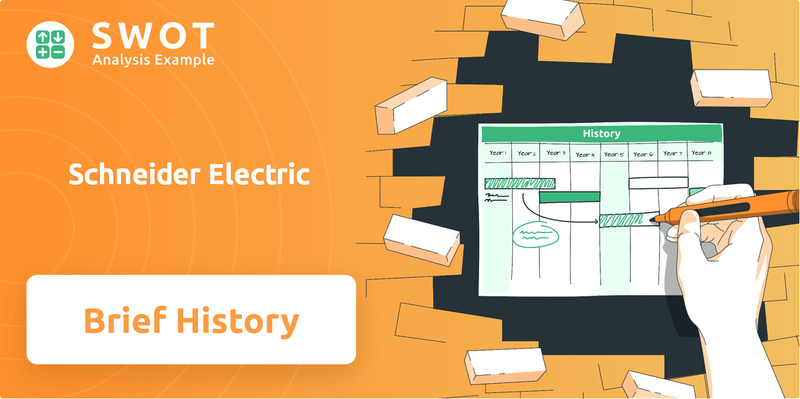
The Schneider company's evolution from heavy industry to electrical equipment and, ultimately, to digital automation is a testament to its adaptability. This strategic foresight has positioned Schneider Electric as a pioneer in efficiency and sustainability. Understanding the Schneider Electric company profile reveals key milestones, acquisitions, and innovations that shaped its global presence and strong market position. Explore the history of Schneider Electric timeline to learn about its commitment to empowering everyone to make the most of energy and resources.
What is the Schneider Electric Founding Story?
The journey of Schneider Electric began in 1836, a story of entrepreneurial vision in the heart of France. Founded by brothers Adolphe and Joseph-Eugène Schneider, the company emerged from the acquisition of the Creusot foundries, setting the stage for a significant industrial player. Their early focus on mechanical engineering and iron manufacturing laid the foundation for what would become a global leader in the electrical equipment and industrial automation sectors.
Initially known as Schneider & Cie, the company's early years were marked by strategic investments in infrastructure and heavy equipment. This included the production of machinery and tools, such as the first French locomotive, 'La Gironde,' in 1838. This early venture showcased the company's commitment to innovation and its ability to capitalize on the demands of the First Industrial Revolution. By 1871, Schneider & Cie had evolved into a leading European weapons manufacturer, demonstrating its adaptability and growth.
The company's initial business model centered on large-scale industrial production, reflecting the founders' understanding of the evolving market needs. The name 'Schneider & Cie' highlighted the family's ownership and direct involvement in the industrial operations. While specific details about initial funding sources are not widely publicized, the acquisition of a foundry suggests a significant initial capital investment. The French multinational has since grown into a global powerhouse.
Early focus on mechanical engineering and iron manufacturing. Schneider Electric's early years were marked by strategic investments.
- 1836: Founded by Adolphe and Joseph-Eugène Schneider.
- 1838: Production of 'La Gironde,' the first French locomotive.
- 1871: Became a leading European weapons manufacturer.
- Early business model centered on large-scale industrial production.
Schneider Electric SWOT Analysis
- Complete SWOT Breakdown
- Fully Customizable
- Editable in Excel & Word
- Professional Formatting
- Investor-Ready Format
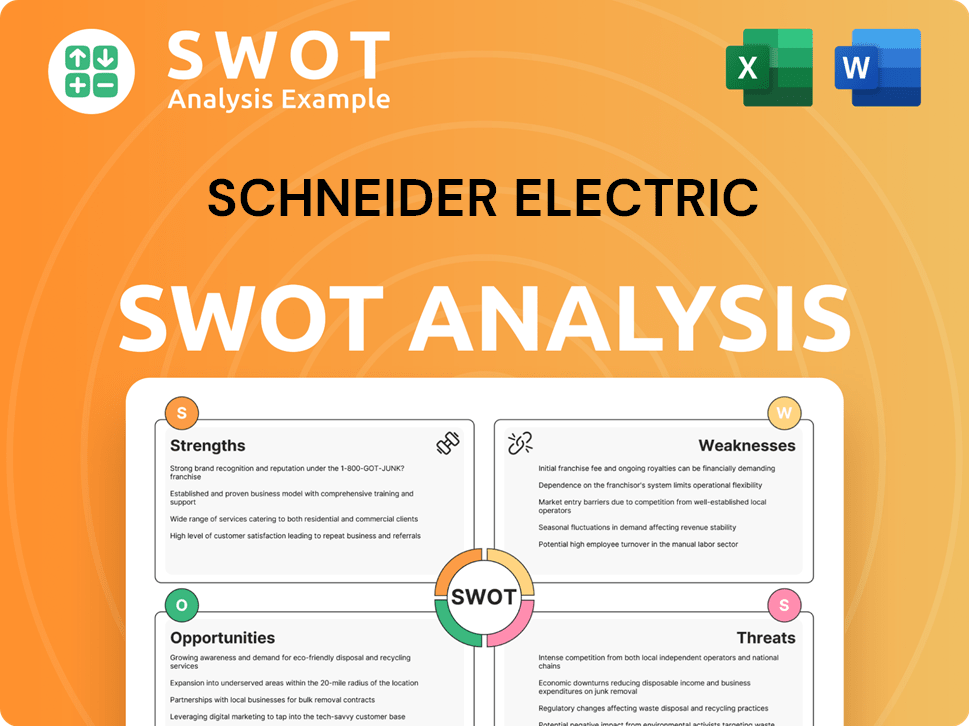
What Drove the Early Growth of Schneider Electric?
The early growth of Schneider Electric, then known as Schneider & Cie, was marked by significant diversification and expansion. Initially rooted in heavy industry, the company evolved through strategic shifts and acquisitions. This period laid the groundwork for its transformation into a global leader in energy management and automation.
During the 19th century, Schneider Electric pioneered iron manufacturing and established steelworks. By 1870, the Le Creusot plant employed approximately 10,000 workers. The company became a leading European weapons manufacturer by 1871, producing new alloys and armor plating. This early focus on heavy industry set the stage for future developments.
A pivotal moment occurred in 1891 when Schneider Electric entered the emerging electricity market. This marked its initial foray into a sector that would define its future. This strategic move signaled a shift towards new technologies and industries. This transition was crucial for the company's long-term growth.
After World War II, Charles Schneider restructured the company in 1949, shifting away from armaments. The focus shifted to Europe's infrastructure needs, including construction, iron, steel works, and electricity. This restructuring was a key step in adapting to changing market demands. The company's focus evolved over time.
The 1960s marked a significant evolution as the company transitioned into electrical equipment. Strategic acquisitions in the late 20th century cemented its focus on the electrical industry. These acquisitions played a crucial role in shaping the company's trajectory. The company's focus became more specialized.
In 1981, Schneider Electric acquired a majority stake in Modicon, introducing programmable logic controllers (PLCs). The acquisition of Telemecanique in 1988, Merlin Gerin in 1992, and Square D in 1991 further strengthened its position. By 1999, the company acquired Lexel and rebranded as Schneider Electric. The merger with Square D in 2000, valued at approximately $2 billion, solidified its presence in North America.
These strategic acquisitions were instrumental in transforming Schneider Electric. From a heavy industry conglomerate to a global specialist in energy management and automation. These acquisitions expanded the company's product range and market reach. This transformation positioned the company for future growth and innovation.
Schneider Electric PESTLE Analysis
- Covers All 6 PESTLE Categories
- No Research Needed – Save Hours of Work
- Built by Experts, Trusted by Consultants
- Instant Download, Ready to Use
- 100% Editable, Fully Customizable
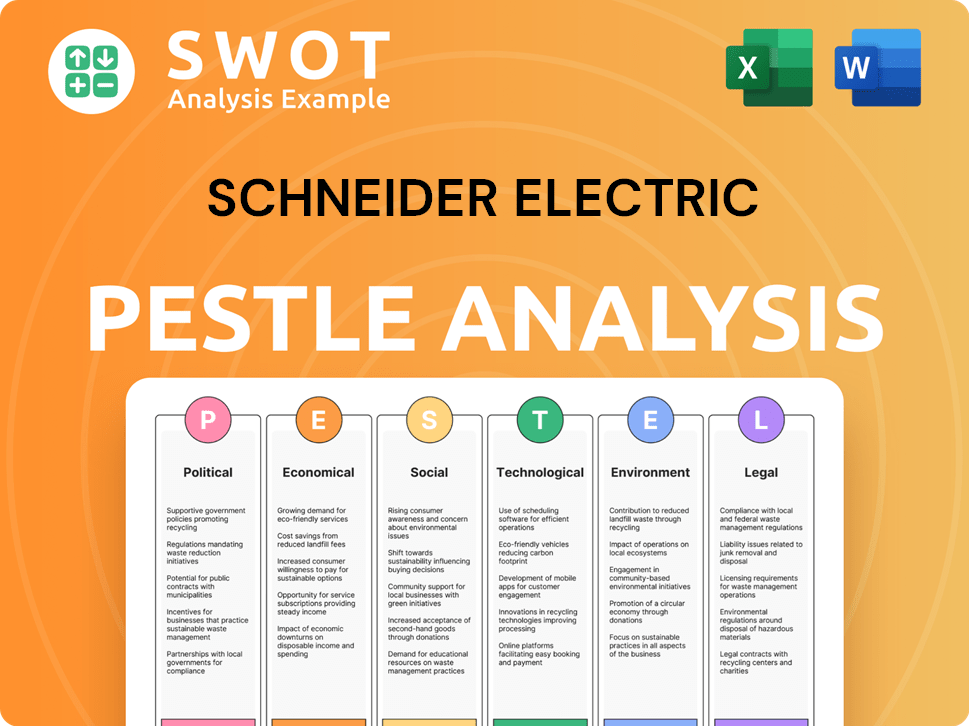
What are the key Milestones in Schneider Electric history?
The history of Schneider Electric is marked by significant milestones in the electrical equipment and industrial automation sectors. From its early years as a steel and shipbuilding firm to its current status as a global leader, the company has consistently adapted and expanded its capabilities through strategic acquisitions and technological advancements. This journey reflects a commitment to innovation and a proactive approach to market dynamics.
| Year | Milestone |
|---|---|
| 1981 | Acquired Modicon, a pivotal move that led to the development of programmable logic controllers (PLCs). |
| 1988 | Acquired Telemecanique, strengthening its position in industrial automation. |
| 1991 | Acquired Square D, further expanding its presence in the North American market. |
| 1992 | Acquired Merlin Gerin, enhancing its global reach in electrical distribution. |
| 2007 | Acquired APC (American Power Conversion) for approximately $6.1 billion, boosting its presence in power distribution and management. |
| 2015 | Launched EcoStruxure, an IoT-enabled architecture and platform. |
| 2024 | Acquired Motivair Corporation for $850 million to strengthen its liquid cooling capabilities. |
| 2025 | Launched an industrial copilot developed with Microsoft to boost productivity and workforce efficiency. |
Innovations have been central to the evolution of
The acquisition of Modicon in 1981 was a pivotal moment, leading to the development of PLCs, which revolutionized industrial automation.
Launched in 2015, this IoT-enabled architecture and platform optimizes energy and operational efficiencies across various industries, driving digital transformation.
The 2024 acquisition of Motivair Corporation expanded capabilities in liquid cooling, essential for high-performance computing and AI applications.
In May 2025, the launch of an industrial copilot developed with Microsoft aimed to boost productivity and workforce efficiency in manufacturing.
The company's commitment to sustainability is reflected in its goals to achieve net-zero emissions by 2025 and use 100% renewable electricity by 2025.
Key acquisitions like Telemecanique, Square D, and Merlin Gerin expanded the company's global presence and product offerings in electrical equipment and industrial automation.
Challenges for
The company has faced challenges from market fluctuations, as seen in the 2024 decline in the Industrial Automation business.
Adapting to a competitive landscape requires continuous innovation and strategic investments to maintain market share.
The company must continuously evolve to stay ahead of technological changes, such as the rise of AI and the demand for advanced cooling solutions.
Rising production costs and economic uncertainties have impacted financial performance, requiring strategic adjustments.
The company invests heavily in research and development, with €1.4 billion spent in 2022, to drive innovation and maintain a competitive edge.
Meeting sustainability goals, such as achieving net-zero emissions by 2025, presents both a challenge and an opportunity for innovation.
Schneider Electric Business Model Canvas
- Complete 9-Block Business Model Canvas
- Effortlessly Communicate Your Business Strategy
- Investor-Ready BMC Format
- 100% Editable and Customizable
- Clear and Structured Layout
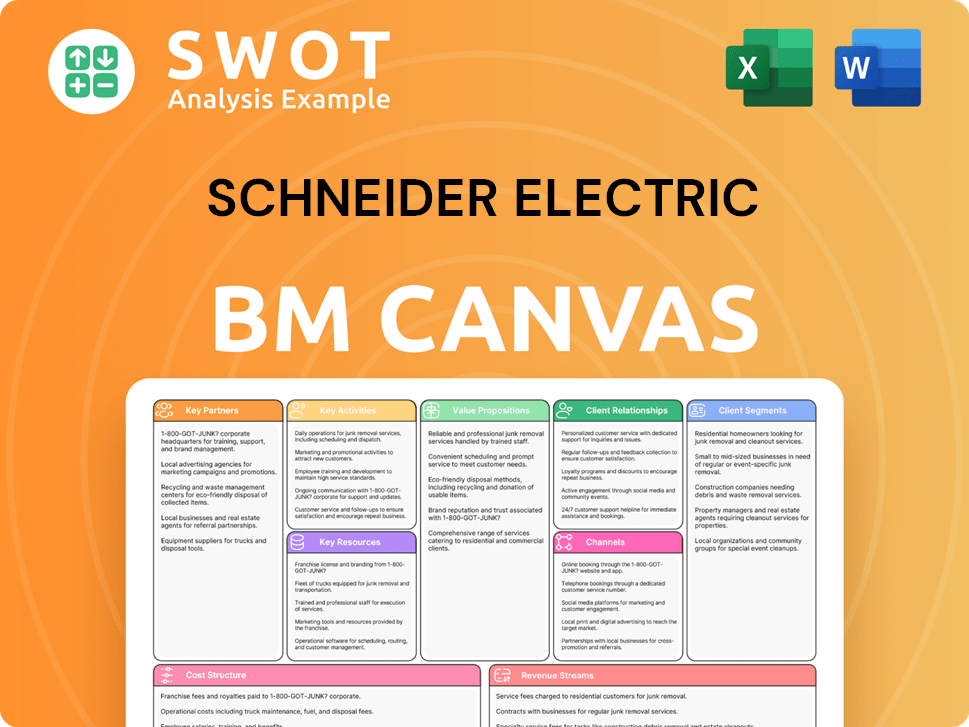
What is the Timeline of Key Events for Schneider Electric?
The Owners & Shareholders of Schneider Electric timeline showcases a remarkable evolution from its origins in the 19th century to its current status as a global leader. The Schneider Electric company's journey is marked by strategic acquisitions and a consistent focus on innovation within the electrical and industrial automation sectors. This Schneider history is a testament to its adaptability and vision.
| Year | Key Event |
|---|---|
| 1836 | Brothers Adolphe and Joseph-Eugène Schneider established Schneider & Cie, taking over the Le Creusot foundry. |
| 1891 | The French multinational entered the burgeoning electricity market. |
| 1949 | Charles Schneider reorganized the company, shifting its focus from armaments to construction and electricity. |
| 1960s | Schneider transitioned into electrical equipment. |
| 1981 | Acquisition of Modicon, a key player in programmable logic controllers (PLCs). |
| 1988 | Acquisition of Telemecanique. |
| 1991 | Acquisition of Square D. |
| 1992 | Acquisition of Merlin Gerin. |
| 1999 | The company was renamed Schneider Electric, emphasizing its electrical expertise. |
| 2000 | Merger with American company Square D. |
| 2007 | Acquisition of APC (American Power Conversion). |
| 2015 | Launch of the 'Open Innovation' program and EcoStruxure, an IoT-enabled architecture. |
| 2024 | Revenue grew by 6.3% to €38 billion, with a net profit of €4.27 billion, up 7%. Acquisition of Motivair Corporation for $850 million. |
| 2025 | Ranked as the world's most sustainable company by Corporate Knights. Launches new automation solutions including Modicon M660 and Modicon Edge I/O NTS, and an industrial copilot developed with Microsoft. Introduces the AI-powered One Digital Grid Platform. |
Schneider Electric aims to achieve net-zero emissions across its operations by 2025 and across its value chain by 2040. The company's commitment to sustainability is a core driver of its future strategy. It is ranked as the world's most sustainable company by Corporate Knights in 2025.
The company anticipates continued market demand in data centers, networks, buildings, industry, and infrastructure. It reaffirms a target for Adjusted EBITA growth between +10% and +15% organically, driven by +7% to +10% organic revenue growth. Analyst predictions for Schneider Electric's stock in 2025 show an average price target of €248.21 to €250.33.
Schneider Electric is advancing its subscription-based software model and leveraging its multi-hub setup for agile management. The company's focus on innovation includes the launch of new automation solutions and an industrial copilot developed with Microsoft. It is also introducing the AI-powered One Digital Grid Platform.
Schneider Electric is committed to achieving 90% employee engagement by 2024 and 50% women in its workforce by 2025. The company's leadership continues to emphasize innovation and sustainability as core drivers for future growth, tying back to the founding vision of leveraging industrial advancements for societal benefit.
Schneider Electric Porter's Five Forces Analysis
- Covers All 5 Competitive Forces in Detail
- Structured for Consultants, Students, and Founders
- 100% Editable in Microsoft Word & Excel
- Instant Digital Download – Use Immediately
- Compatible with Mac & PC – Fully Unlocked
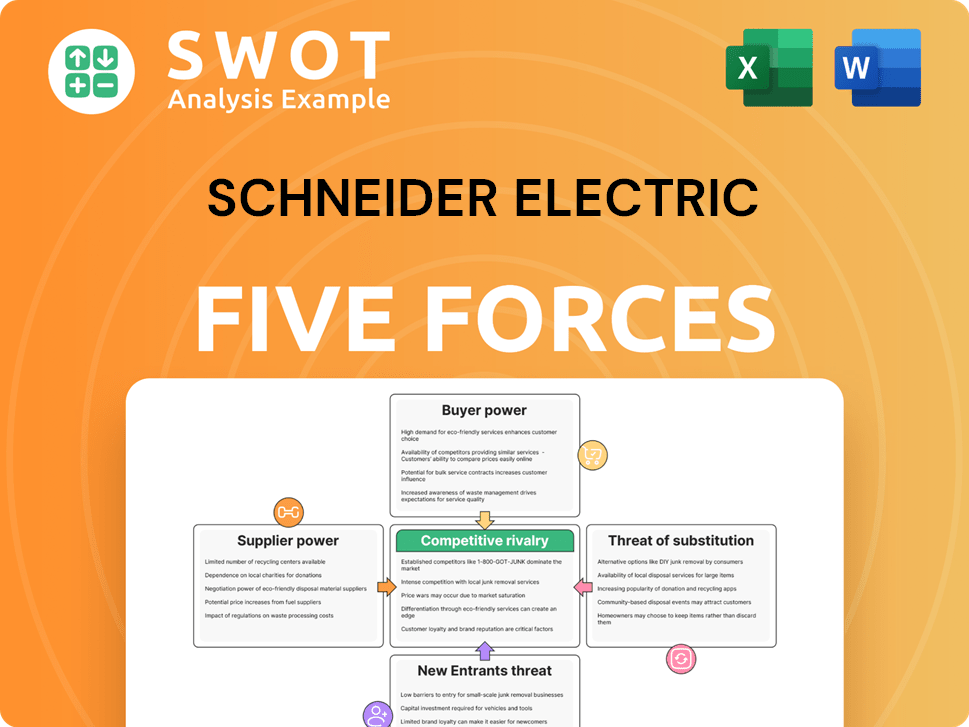
Related Blogs
- What is Competitive Landscape of Schneider Electric Company?
- What is Growth Strategy and Future Prospects of Schneider Electric Company?
- How Does Schneider Electric Company Work?
- What is Sales and Marketing Strategy of Schneider Electric Company?
- What is Brief History of Schneider Electric Company?
- Who Owns Schneider Electric Company?
- What is Customer Demographics and Target Market of Schneider Electric Company?
Disclaimer
All information, articles, and product details provided on this website are for general informational and educational purposes only. We do not claim any ownership over, nor do we intend to infringe upon, any trademarks, copyrights, logos, brand names, or other intellectual property mentioned or depicted on this site. Such intellectual property remains the property of its respective owners, and any references here are made solely for identification or informational purposes, without implying any affiliation, endorsement, or partnership.
We make no representations or warranties, express or implied, regarding the accuracy, completeness, or suitability of any content or products presented. Nothing on this website should be construed as legal, tax, investment, financial, medical, or other professional advice. In addition, no part of this site—including articles or product references—constitutes a solicitation, recommendation, endorsement, advertisement, or offer to buy or sell any securities, franchises, or other financial instruments, particularly in jurisdictions where such activity would be unlawful.
All content is of a general nature and may not address the specific circumstances of any individual or entity. It is not a substitute for professional advice or services. Any actions you take based on the information provided here are strictly at your own risk. You accept full responsibility for any decisions or outcomes arising from your use of this website and agree to release us from any liability in connection with your use of, or reliance upon, the content or products found herein.